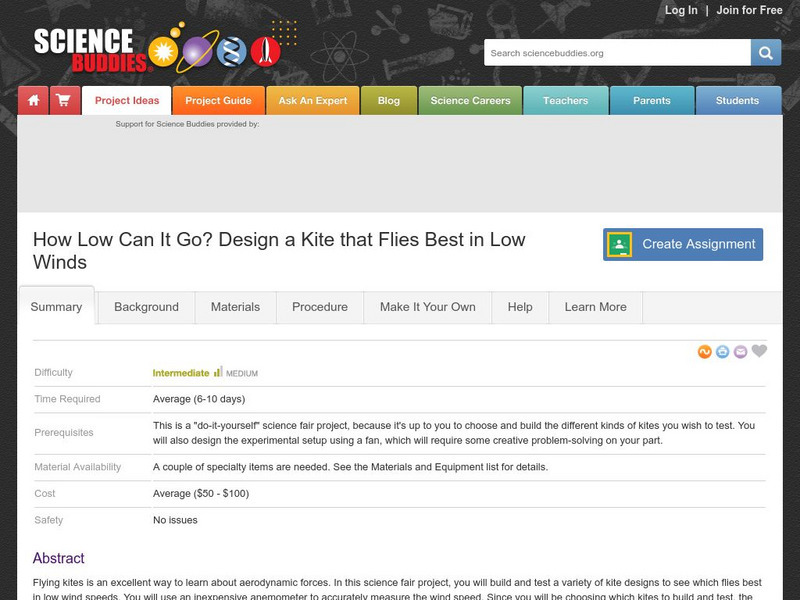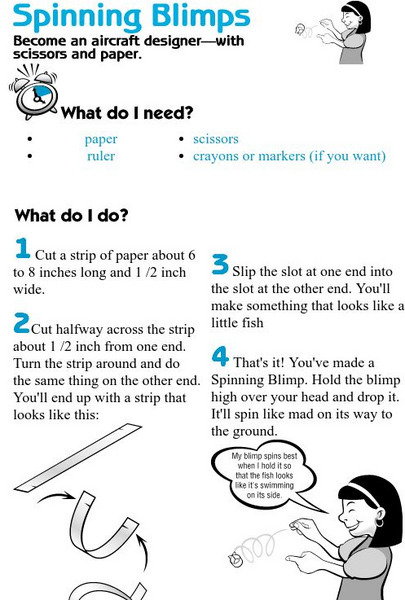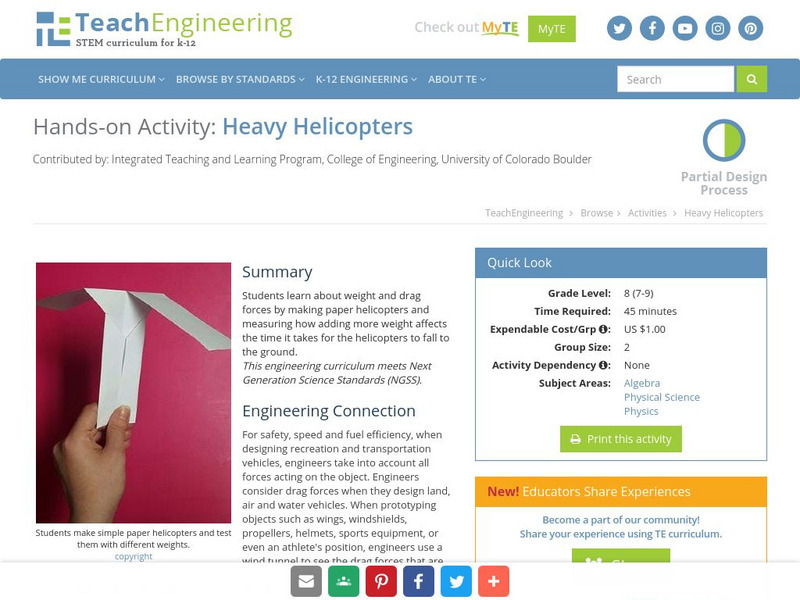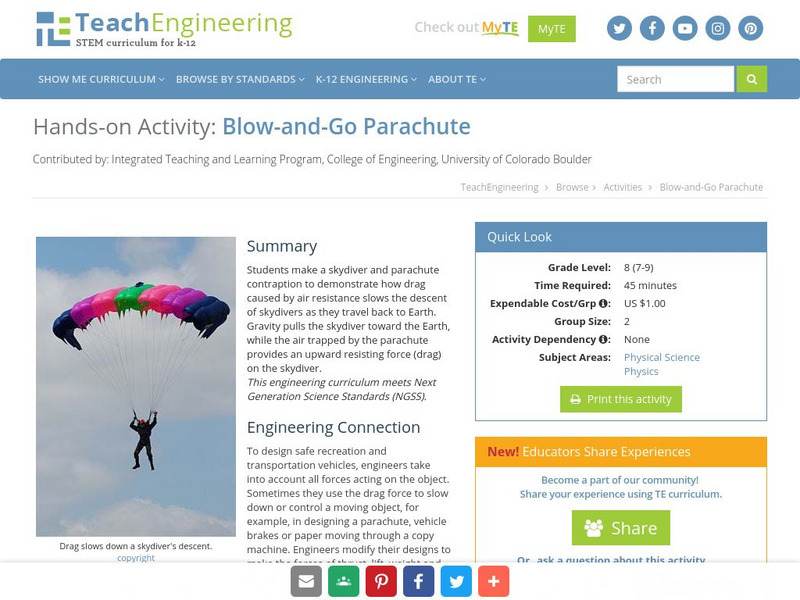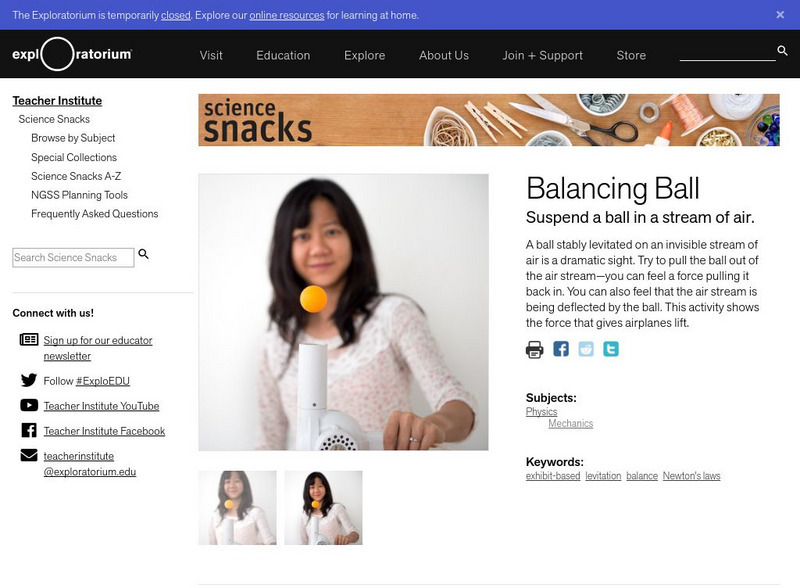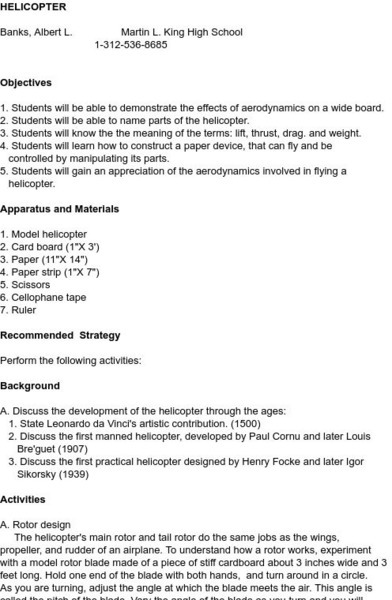Science Buddies
Science Buddies: Project Ideas: Design a Kite That Flies Best in Low Winds
In this science fair project, use a fan and an anemometer to test various kite designs to see which will fly best in low wind speed. The Science Buddies project ideas are set up consistently beginning with an abstract, objective, and...
Science Buddies
Science Buddies: Project Ideas: Whirl Y Bird vs. Whale Y Bird
Improve the design of a very simple aircraft, the whirlybird, and learn about hydrodynamics and biomimicry in this science experiment. The Science Buddies project ideas are set up consistently beginning with an abstract, objective, and...
TeachEngineering
Teach Engineering: Building Tetrahedral Kites
Students build a tetrahedral kite and test it out. While building they are learning about flight and the manufacturing process
Exploratorium
Exploratorium: Hoopster
Students create their own airplane using straws and other materials and learn the principles of aerodynamics.
Exploratorium
Exploratorium: Spinning Blimps
Students create a blimp and then experiment with the design to improve its aerodynamics.
Exploratorium
Exploratorium: Roto Copter
Students can experiment with a home-made helicopter that lets them change the blades to see how real aerodynamics work.
Exploratorium
Exploratorium: Paper Airplanes
At this site students will use origami to fold a paper airplane that fly better than the classic dart airplane.
TeachEngineering
Teach Engineering: Heavy Helicopters
Students learn about weight and drag forces by making paper helicopters and measuring how adding more weight affects the time it takes for the helicopters to fall to the ground.
TeachEngineering
Teach Engineering: Blow and Go Parachute
Students make a skydiver and parachute contraption to demonstrate how drag caused by air resistance slows the descent of skydivers as they travel back to Earth. Gravity pulls the skydiver toward the Earth, while the air trapped by the...
NASA
Nasa: Beginner's Guide to Aerodynamics
Includes exhaustive information and a wealth of activities pertaining to aerodynamics and the physics of flight.
Exploratorium
Exploratorium: The Science of Sports Cycling
A detailed look at the aerodynamic principles associated with cycling. Good science and even better web page design. Includes an online calculator that allows the user to calculate the aerodynamic drag and propulsive power of a bicyclist...
Science and Mathematics Initiative for Learning Enhancement (SMILE)
Smile: Lab Activity: Aviation
This site from the Illinois Institute of Technology provides a student lab activity in which the flight of a paper airplane is investigated and studied. Designed for primary grades, but easily adaptable for junior high students.
Michigan Reach Out
Nasa Trc: Flying Wing
In this lesson plan students can make a flying wing and trouble-shoot until the wing glides smoothly.
Michigan Reach Out
Reach Out!: Making Paper Airplane Gliders
Students learn the fundamentals of aerodynamics in this hands-on exercise.
Michigan Reach Out
Nasa Trc: Maple Seed Helicopters
Students study the aerodynamic properties of a maple seed and then apply what they observe making their own flying object.
Other
Easy to Make Paper Airplanes
Have fun making different kinds of flying vehicles. You will learn how to make a paper airplane, helicopter, rocket, blimp, etc.
Exploratorium
Exploratorium: Science Snacks: Balancing Ball: Suspend a Ball in a Stream of Air
In this lesson plan students learn about air flow using a suspended ball in an air stream.
Treehut
Suzy's World: Aerodynamics
Use this fact sheet to find out what makes things fly with this fact sheet on aerodynamics.
University of Minnesota
The Physics of Flight: Bernoulli's Principle
Discusses air flow around the wing of a plane and its effect upon the lift and drag forces. Focuses on the application of Bernoulli's principle to wing design and the subsequent airfoil shapes.
Science and Mathematics Initiative for Learning Enhancement (SMILE)
Smile: Lab Activity: Helicopter
The Illinois Institute of Technology lets students investigate the aerodynamics of a helicopter, focusing on the variables which effect the lift, thrust, drag, and weight. Students investigate the effects of aerodynamics on a wide board.
Science and Mathematics Initiative for Learning Enhancement (SMILE)
Smile: Lab Work: Come Fly With Me
This site by the Illinois Institute of Technology lets students use a vacuum cleaner hose, ping pong balls, straws and other materials to investigate the effect of moving air upon the surfaces which it hits. Principles are applied as...
Museum of Science
Museum of Science and Industry, Chicago: Activities: Make and Fly a Helicopter
Print and cut out the template for the helicopter. Then experiment with adding and subtracting weight, or changing the shape of the copter or the blades to see what makes it fly best.


